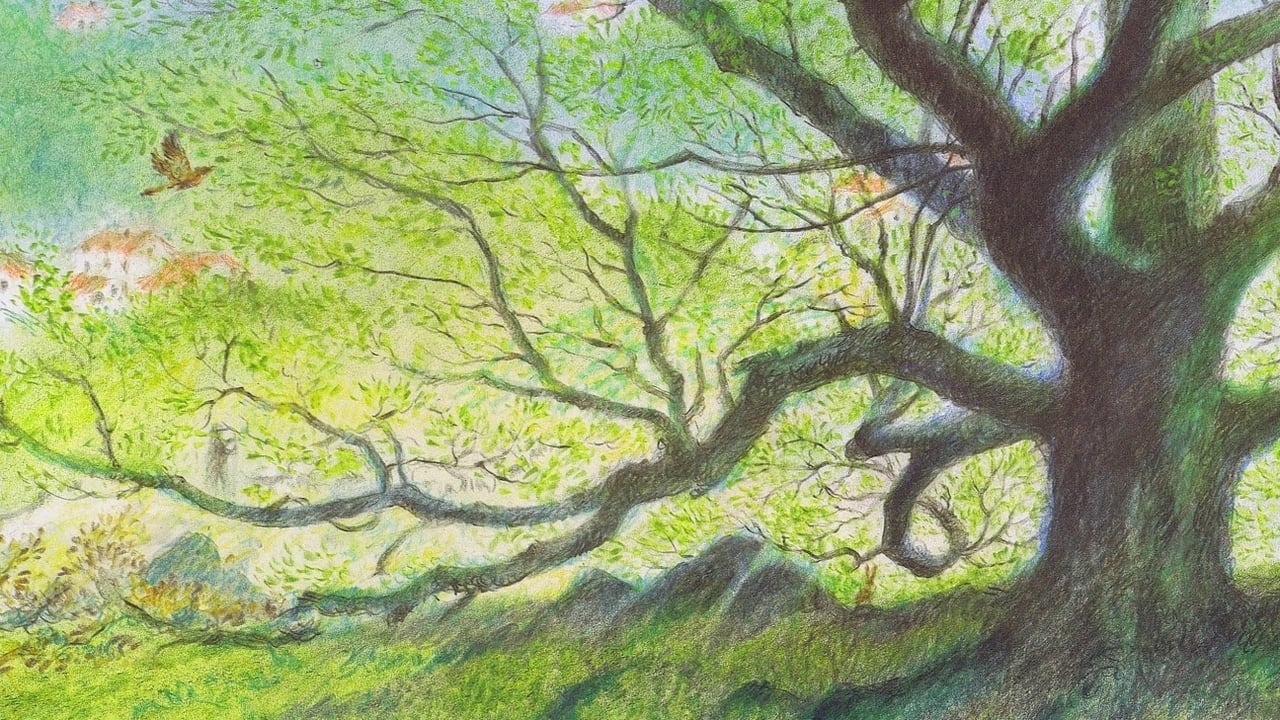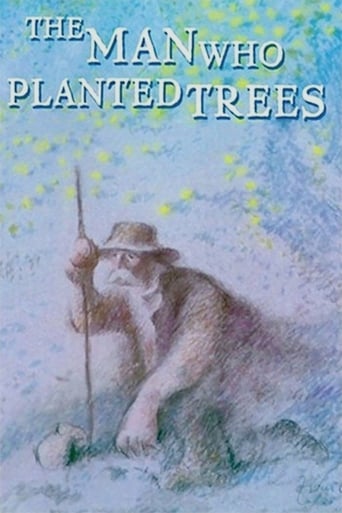

Too many fans seem to be blown away
... View MorePlot so thin, it passes unnoticed.
... View MoreAm I Missing Something?
... View MoreThe tone of this movie is interesting -- the stakes are both dramatic and high, but it's balanced with a lot of fun, tongue and cheek dialogue.
... View MoreSimple story of the power of a life of hope, generosity, and perseverance.Animated, well-drawn.A man spends years planting trees, gradually transforming a wasteland into a forest; changes the area from one supporting a few ornery people into thriving towns.Seems like a true story.Set in the years between WWI and WWII in Provence, in southeastern France, at an altitude of about 1000 meters.Well done, worth a look.
... View MoreI excessively quote about Leo Tolstoy and his works nowadays in whatever I write since I'm on the verge of finishing his masterpiece 'War and Peace'. The reason for this is the universal truths that are constantly invoked in the book through the events in the lives of its characters. In one of the paragraphs, Tolstoy describes a real life character Dokhturov as 'a person who was considered inferior to others and quite neglected while quoting history but stood valiantly in the thickest of battles and the trickiest of situations without consideration for his own life. Such people were forgotten soon because people usually do not notice the most consistent and essential people but the ones who have stood because of some reasons. People such as Dokhturov are like the cog wheels in machines that quietly spin and run the entire system but most tyros who see the machines functioning oddly will foolishly assume a tiny visible chip to be the most significant part.'Elzéard Bouffier is such a character; he is least perturbed by the World Wars and any other political situation happening around him. His only ethos is to serve Mother Nature that has provided him his fundamental needs – food, water, shelter, clothing and most importantly, life. He tends sheep, raises bees and plants trees everyday; he does not blow his own trumpets, he doesn't want fame, glory and recognition, all he wishes to do is to serve nature and humanity. Like the cog wheel he does his work brilliantly, but remains unnoticed, unrecognized and he wants it that way. And indeed we the audience do not hear Elzéard speaking but are introduced to him by a nameless narrator who dedicates the entire short to the former. How ironic is it that while Elzéard remains nameless in his world, we the audience know his name and not the narrator's!The story begins with a hazy view of the sky and birds and then closes in on nebulous clumps of brown that represent hills and valleys. Our young narrator then begins reciting his journey – he wanders lonely in the hills with no water and not much hope to live. Shapes begin forming at a distance and we realize there is a small town ahead albeit a decrepit one who's church remains undamaged but deserted. He vainly searches for water in the town and leaves the place soon. His eyes are caught by the sight of a tall object in the distance which he assumes to be a tree stump but later realizes it's a shepherd with a stick in his hand. The kind shepherd offers him water and takes him along to his home; the narrator observes that though the man is extremely quiet, his eyes seem to show keen discernment and determination. At the shepherd's abode, the narrator is offered soup and later the two of them sit at the table where the shepherd, Elzéard Bouffier begins segregating seeds of acorns on the basis of their quality. The narrator offers help, but Bouffier doesn't need it as he knows only he has the eyes for such a task. He selects the best hundred acorns and puts him in his tiny bag. The inquisitive narrator is so intrigued by the man he makes an excuse not to leave the next day only to know more about Bouffier. He finds out that the man is on a mission to plant trees wherever the soil is favorable and has already planted a hundred thousand seeds in the last three years. The writer then meets him after the First World War to see that entire area is burgeoning with growing trees and young streams. His unique relationship with this altruist, environmentalist and visionary continues throughout their lives and we blessed viewers get to be a part of it.Frederic Back's works give us a feeling as if we are in a dream, however, we aren't just in any dream but one that we shall remember for a long time. This style suits short stories that are generally transient in nature- people generally don't phase out short stories as they do while writing novels; shorts come spontaneously and produce the best result when they are still fresh in mind. This artistic form wouldn't suit full length Pixar films but they create a magical effect here. Notice the scene where we see the narrator holding a bowl in his hand in the right part of the frame, and a hand and vessel magically appear on the left side to serve the writer his soup. Or the transition where the wall in Bouffier's house transforms into his cloak in the next scene. Or the herd of sheep becoming warring soldiers in the subsequent scene. Or the distorted scene that depicts the plight of the villagers. Every single frame comes alive with the use of wax pencils on frosted cel – a translucent material that is superimposed on a basic frame in order to give depth to an image. Since much of the work is hand drawn, the director has a lot more freedom to dabble with his work and provide that storytelling feel. And how can we forget the terrific use of sound that enchants us right from the beginning as we hear the clear music in the background and the audible footsteps of our narrator to the later portion where nature and human sounds dominate the picture?My university had organized an Environment Awareness event recently where I was in the management team. Almost the entire event was marked with amateur performances, skits and poems, and in the end, I was shocked that the most important part of planting seeds was subordinated to a feeble ten minutes where we actually had to scatter the seeds that were placed inside balls of mud! Is this true compassion towards nature? Of course not. True passion comes from those people who like tiny cog wheels that operate actively but invisibly.
... View MoreFrédéric Back's 30 minutes long Oscar winning animated film "The Man Who Planted Trees" is astounding work of art with its beautiful story and the images that equal it. The story written by the French writer Jean Giono that tells about Elzeard Bouffier, a quiet shepherd, and later bee keeper who never talked much but over 35 years of hard work singlehandedly cultivated a magnificent forest in a desolate area of Provence, France and made it a peaceful and happy home for over 10, 000 people, is highly moving, inspirational, and life-affirming. It makes a viewer proud of what a man can achieve if he is determined to create, not to destroy. Every frame looks and feels not like a flat drawing but like a beloved painting of a celebrated impressionist painter (Monet, Sisley, Morisot, and Pissarro, the "purest" impressionists come first to mind). To achieve this effect, Back worked on unpolished acetates using crayons and modulating the colors. During the film, the colors change dramatically from barren and lifeless desert like palette in the beginning to the tender glowing delicate colors of blossoming eternal Spring in the final scenes. I was absolutely mesmerized by Back's visual style and his ability to beautifully translate such a literally story to the screen and not to lose any of its appeal but on the contrary to enrich it with incredible taste and unique exquisite beauty and tenderness of his images. For the first time, I came across the work of animation that reminded me so much of my all time favorite animated film "Tale of Tales" by Yuri Norstein, artistically and spiritually. It was not surprising for me to find out that Norstein and Back have met, respect and admire each other work and that Norstein studied Back's techniques and took with him to Moscow Back's acetates and coloring pencils that he was going to use while working on his ambitious project, full feature animation "Overcoat".There is one question that pops up from time to time on the different IMDb boards, "Is there any movie that all viewers would love and cherish"? I am always skeptical and up until tonight used to believe that the universally loved movie simply does not exist. I am happy to admit that I was wrong. I don't think that anyone who saw this little marvel may not be affected by its clear message, its kindness, beauty, and artistry.
... View MoreThis movie is absolutely the best short movie I've ever seen. In only about 30 minutes shows the spirit of a "holy" man, his power, his endurance, his hope to make world beautiful and happy. He turns dead to life, rock to tree, madness to happiness and joy.At the beginning I though, that it will be another nice, interesting made, movie, but as the time continued I revealed a great global idea, which make this movie so optimistic.This picture attacked me strong and at the end I had to take my tears from my eyes. Person without "heart on the right side" can't understand it. This is a story for all "busy"ness and fast-living people of nowadays.My advice is: See it, after you'll understand it!"
... View More